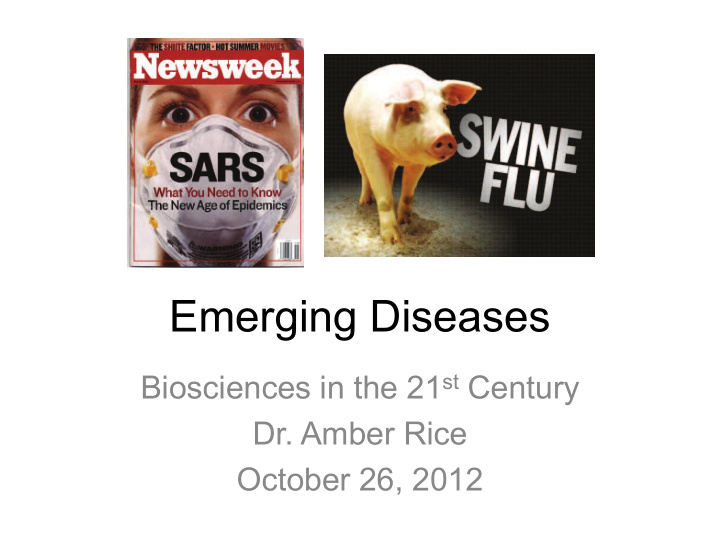



Emerging Diseases Biosciences in the 21 st Century Dr. Amber Rice October 26, 2012
Outline • Disease emergence: a case study • Introduction to phylogenetic trees • Introduction to natural selection • How do pathogens shift hosts? • The evolution of virulence
Disease emergence: a case study SARS: Severe Acute Respiratory Syndrome • First detected in China, November 2002 • Spread quickly • 10% fatality rate Nature , 2003
Disease emergence: a case study What was it? Where did SARS come from?
Outline • Disease emergence: a case study • Introduction to phylogenetic trees • Introduction to natural selection • How do pathogens shift hosts? • The evolution of virulence
Phylogenetic tree: A visual representation of the evolutionary history of populations, genes, or species
Constructing phylogenies with sequence data
Reading a phylogenetic tree
No currently existing species is ancestral to any other
Different arrangements show the same relationships There is no linear ancestor-descendent relationship! Humans did not evolve from cats or fish!
Phylogeny of HIV Three separate introductions from chimpanzees
Back to our case study: the emergence of SARS Palm civet Bat
Outline • Disease emergence: a case study • Introduction to phylogenetic trees • Introduction to natural selection • How do pathogens shift hosts? • The evolution of virulence
What is evolution? Evolution is a change in a population’s allele frequencies over time. Generation t Generation t+1 aa Aa AA Aa AA AA Aa Aa time AA AA aa AA AA AA aa AA aa AA Aa Aa 70% A 60% A 30% a 40% a
Natural selection is one mechanism of evolution Natural selection: differential reproductive success – Non-random – Not forward-looking, can only work with existing variation – Only adaptive mechanism of evolution Figure: Univ. of Calif. Mus. of Paleontology’s Understanding Evolution Site
Evolution by natural selection Ingredients needed for evolution by natural selection • Variation in traits • Inheritance • Differential reproduction (natural selection) End result: Traits that increase reproductive success increase in frequency in a population. Figure: Univ. of Calif. Mus. of Paleontology’s Understanding Evolution Site
Outline • Disease emergence: a case study • Introduction to phylogenetic trees • Introduction to natural selection • How do pathogens shift hosts? • The evolution of virulence
Shifting to another host species • phi 6: virus that infects bacteria (bacteriophage) • phi 6 only infects Pseudomonas syringae
Shifting to another host species • Could phi 6 switch hosts? • Plated on 14 different Pseudomonas species • A few viruses infected and survived • All had mutation in protein for attaching to host Duffy et al. 2007
Shifting to another host species • Once in a new host, must adapt quickly • Slow growth can lead to extinction • Host switching leads to strong selection: – Infection – Evade immune system and replicate • What factors allow pathogens to evolve quickly?
Outline • Disease emergence: a case study • Introduction to phylogenetic trees • Introduction to natural selection • How do pathogens shift hosts? • The evolution of virulence
Evolution of virulence: a trade-off
Mode of transmission affects virulence Direct transmission, vectorborne, waterborne
Mode of transmission affects virulence
Mode of transmission affects virulence
Back to our case study: virulence in SARS • Wanted: an animal model for SARS • Problem: SARS slowly replicates in mice, but mice do not get sick • Solution: create selection for increased virulence of SARS in mice 1. Infect mouse with SARS 2. After 2 days, purify virus from lungs and infect new mice 3. Repeat, 14 times Roberts A, Deming D, Paddock CD, Cheng A, et al. (2007)
Back to our case study: virulence in SARS Infected with SARS Infected with MA15-low dose Infected with MA15-high dose Roberts A, Deming D, Paddock CD, Cheng A, et al. (2007)
Evolution of virulence: implications for public health Select for lower virulence by interfering with transmission • Improve hygiene • Wear masks • Provide clean water • Widespread vaccination
Current research aims • Can we predict which pathogens are more likely to shift to humans? • What makes some strains so much more deadly than others? • How can we develop effective new vaccines and drugs?
Key points • New diseases are constantly arising • Evolution can help us determine 1. what they are 2. where they came from 3. how they infected humans 4. how they become more/less virulent 5. how best to fight them • No currently existing species is ancestral to any other • Virulence is a trade-off between fast replication and transmission • Transmission mode affects virulence
Recommend
More recommend